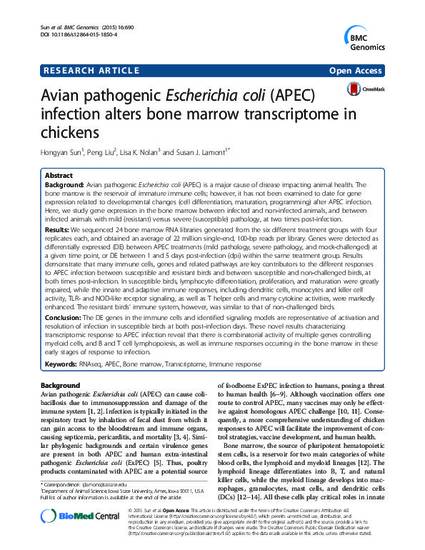
Avian pathogenic Escherichia coli (APEC) is a major cause of disease impacting animal health. The bone marrow is the reservoir of immature immune cells; however, it has not been examined to date for gene expression related to developmental changes (cell differentiation, maturation, programming) after APEC infection. Here, we study gene expression in the bone marrow between infected and non-infected animals, and between infected animals with mild (resistant) versus severe (susceptible) pathology, at two times post-infection. We sequenced 24 bone marrow RNA libraries generated from the six different treatment groups with four replicates each, and obtained an average of 22 million single-end, 100-bp reads per library. Genes were detected as differentially expressed (DE) between APEC treatments (mild pathology, severe pathology, and mock-challenged) at a given time point, or DE between 1 and 5 days post-infection (dpi) within the same treatment group. Results demonstrate that many immune cells, genes and related pathways are key contributors to the different responses to APEC infection between susceptible and resistant birds and between susceptible and non-challenged birds, at both times post-infection. In susceptible birds, lymphocyte differentiation, proliferation, and maturation were greatly impaired, while the innate and adaptive immune responses, including dendritic cells, monocytes and killer cell activity, TLR- and NOD-like receptor signaling, as well as T helper cells and many cytokine activities, were markedly enhanced. The resistant birds’ immune system, however, was similar to that of non-challenged birds. The DE genes in the immune cells and identified signaling models are representative of activation and resolution of infection in susceptible birds at both post-infection days. These novel results characterizing transcriptomic response to APEC infection reveal that there is combinatorial activity of multiple genes controlling myeloid cells, and B and T cell lymphopoiesis, as well as immune responses occurring in the bone marrow in these early stages of response to infection.
Available at: http://works.bepress.com/lisa_nolan/85/

This article is from BMC Genomics 16 (2015): 690, doi:10.1186/s12864-015-1850-4. Posted with permission.